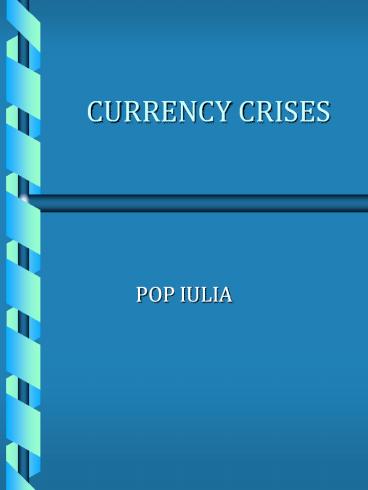CURRENCY CRISES - PowerPoint PPT Presentation
Title:
CURRENCY CRISES
Description:
The First-Generation Models - Latin American crises in the 1980s ... Multiple equilibria and herding behavior by investors. How do these models perform empirically? ... – PowerPoint PPT presentation
Number of Views:628
Avg rating:3.0/5.0
Title: CURRENCY CRISES
1
CURRENCY CRISES
- POP IULIA
2
Introduction
- Importance and objectives of currency crises
models - Empirical results an effective warning system
should consider a broad variety of indicators
3
SOURCES OF SPECULATIVE ATTACKS
- The First-Generation Models - Latin American
crises in the 1980s - Krugman (1979) and Flood and Garber (1984)
- The approach inconsistency between a fixed
exchange rate rule and the pursuit of domestic
policies such as monetising large fiscal and
current account deficits - The sudden speculative attacks on currencies
are rational
4
SOURCES OF SPECULATIVE ATTACKS
- The Second-Generation Models - European Exchange
Rate Mechanism crises 1992-1993 - Obstfeld (1994,1996)
- The approach dynamic interactions of market
expectations and the conflicting objectives of
the government gt self-fulfilling run on the
domestic currency - Multiple equilibria and herding behavior by
investors
5
How do these models perform empirically?
- The empirical literature has not been able to
determine whether first or second-generation
models are better explaining currency crashes - Indicators such as the real exchange rate,
foreign reserves and a weak banking system are
useful in predicting crises
6
SOURCES OF SPECULATIVE ATTACKS
- The Third-Generation Models Asian Crisis
1997-1998 - Eichengreen, Rose and Wyplosz (1995), Sachs,
Tornell and Velasco (1996), Kaminsky, Lizondo and
Reinhart (1997, 1998) - Focus on a broader set of fundamentals
political, institutional, financial variables - What indicators worked best
- international reserves
- real exchange rate
- credit growth
- export performance
- domestic inflation
7
THE NONPARAMETRICAL SIGNALS APPROACH
- It involves monitoring the evolution of a number
of economic variables when one of these
variables deviates from its normal level beyond
a threshold, this is taken as a warning signal
about a possible currency crisis within a
specified period of time - The definition of a currency crisis a situation
in which an attack on the currency leads to a
sharp depreciation of the currency, a large
decline in international reserves, or a
combination of the two.
8
THE METHOD
- The countries
- Hungary Austria
- Romania Germany
- Poland Greece
- Slovak Republic Italy
- Turkey Spain
- Russian Federation
- The sample length 1994-2000
- The signaling horizon 24 months
9
THE EXCHANGE MARKET PRESSURE INDEX
- For each country, crisis is identified ex post by
the behavior of an index - where T (threshold level) is set at three
standard deviations from the mean - where monthly percentage changes in the
exchange rate - where monthly percentage changes in the
international reserves - The weights are chosen so that the two components
of the index have the same variance.
10
THE EXCHANGE MARKET PRESSURE INDEX- results -
- Country Number of Crises Period
- Hungary 0 -
- Romania 2 January 1997
February 1997 - Poland 1 August 1996
- Slovakia 2 March 1999
-
May 1999 - Turkey 1 January 1997
- Russia 2 August 1998
-
September 1998 - Austria 0 -
- Germany 0 -
- Greece 0 -
- Italy 1 February 1998
- Spain 0 -
11
THE EXCHANGE MARKET PRESSURE INDEX
- Romania
- The results are consistent with the IMF Country
Report 01/16 for Romania. - The evolution of the index does not reflect the
1998 contagion effects of the Russian financial
crisis and the 1999 pessimistic expectations of
the market .
12
THE INDICATORS
- The choice of indicators was dictated by
theoretical considerations and by the
availability of information on a monthly data.
They are - exports (in U.S. dollars)
- imports (in U.S. dollars)
- monetary aggregate M1
- real exchange rate
- gross international reserves
- For all these variables the indicator on a given
month was defined as the percentage change in the
level of the variable with respect to its level a
year earlier gt the comparability of units across
countries, it eliminates the seasonality effects
13
DEFINITIONS
- Signaling horizon the period within which the
indicator would be expected to have an ability
for anticipating crises, and is defined a priori
as 24 months. - Signals an indicator is said to issue a signal
whenever it departs from its mean beyond a given
threshold level. - Thresholds are defined in relation to
percentiles of the distribution of observations
for each indicator. While the percentile used as
reference (20) is uniform across countries, the
corresponding indicator-specific thresholds are
different.
14
DEFINITIONS
- The performance of each indicator is examined in
terms of the following matrix - Crisis No
crisis - (within 24
months) - Signal was issued A B
- No signal was issued C D
- A no. of months in which the indicator issued a
good signal - B no. of months in which the indicator issued a
bad signal or noise - C no. of months in which the indicator failed
to issue a signal - D no. of months in which the indicator
refrained from issuing a signal
15
EMPIRICAL RESULTS- information on the
performance of individual indicators is presented
in the next table -
- Final Results
- - tendency of indicator to issue good signals
- RER
- Imports
- Exports
- Reserve
- - tendency of indicators to issue bad signals
- Imports
- Exports
- - noise/signal ratio
- Reserves
- RER
16
ROMANIA - EMPIRICAL RESULTS
- 1. The outcome of the analysis is consistent with
the theoretical and empirical currency crises
literature - 2. The real exchange rate and international
reserves are the indicators with the highest
power of anticipating a crisis situation on the
foreign exchange market































